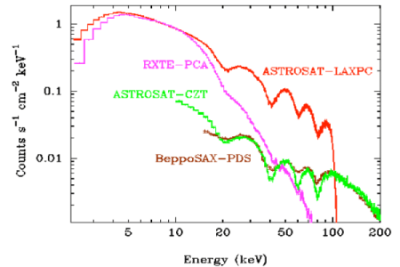Science with ASTROSAT LAXPC:
The three LAXPC detectors, with their unprecedented sensitivity
in the hard X-ray band, combined with the
Soft X-ray Telescope (SXT) with
its low energy capability will make ASTROSAT an unique observatory
in its time frame. The estimated sensitivity of the LAXPCs is such
that with an exposure of 1 day one will be able to obtain spectra
with good statistical significance for an X-ray source with a flux
of 0.1 milli Crab.
A Crab nebula-like X-ray source will register 12,000 counts per sec
in the LAXPCs. One will be able to successfully search quasi-periodic
oscillations from the X-ray sources in the kHz range if the source
intensity rises above 50 milli Crab level. The sources to be observed
with these detectors will range from the nearby solar-mass Galactic
X-ray binaries to the largest structures in the universe, the clusters
of galaxies. Some of the important astrophysical areas to be probed
by the LAXPCs on the ASTROSAT are the following:
- Broad band spectrum of accreting binary X-ray pulsars will be
characterized to energies extending to 80 keV - a study that
has so far been limited to only a handful of bright sources.
Measurement of magnetic field strength of the X-ray pulsars will
be performed through detection of cyclotron absorption lines.
Due to larger area and better energy resolution, the sensitivity
of the LAXPC array for this measurement is
unmatched in comparison to any other existing experiment.
The simulation shown in the figure below demonstrates the
superior capability of the LAXPC to detect cyclotron lines in
a source such as 4U0115+63.

Simulated X-ray spectrum of the X-ray Pulsar 4U 0115+63
with LAXPC and CZTI on Astrosat. Cyclotron resonance Absorption
features are expected to be detected unambiguously with better
sensitivity compared to the earlier measurements.
LAXPC observations of pulse period variations with luminosity
in the transient X-ray pulsars will also improve the
understanding of the accretion disk-magnetosphere interactions
in these sources.
-
Characterisation of the broad band X-ray spectra of Galactic
and extragalactic black hole sources will be carried out.
LAXPCs will be able to measure the hard X-ray spectrum accurately
for a very large number of galactic and extragalactic black
hole sources.
-
Discovery of new `Accreting Millisecond X-ray Pulsars' will be
possible by LAXPC follow-up observations of the transient sources
that will be discovered by the ASTROSAT
Scanning Sky Monitor. These
objects are the missing link between the millisecond radio pulsars
and the low mass X-ray binaries and the discovery of many more
of this type of objects will give a complete understanding of
the evolution of neutron stars.
-
Possible glitches and non-linear pulse period evolution of
Anomalous X-ray Pulsars (AXPs) and Soft Gamma Repeaters (SGRs)
are important studies related to the test of the Magnetar
hypothesis. After RXTE, the LAXPCs will be the only instrument
capable of carrying out continuous temporal study of about
a dozen of objects suspected to be magnetars.
-
Detection of the kilo-Hertz quasi-periodic oscillations
(kHz QPOs) in X-ray radiation in the low mass X-ray binary systems
is yet to be made in the hard X-ray band. For most sources, the
RXTE-PCA measurements extend only up to about 15 keV. The
LAXPCs will be able to probe the kHz QPOs and kHz oscillations
up to about 50 keV.
-
Non-thermal hard X-ray emission component reported in some clusters
of galaxies is an unresolved mystery. Observations of several
clusters of galaxies with the LAXPCs will enable the study of
Compton scattering of the cosmic microwave radiation in them.
These measurements will also allow the estimation of the
magnetic field strength and the energy density of relativistic
electrons in galaxy clusters.
-
Temporal and spectral studies of X-ray emission from
micro-quasars will be performed to understand the accretion
process close to the central black hole. High
frequency QPOs from the micro-quasars can be detected with high
sensitivity by LAXPCs, providing a tool for measuring the mass
and spin of the black holes.
-
Quasi-periodic and aperiodic variations of Active Galactic Nuclei
(AGNs) have not yet been studied in detail. Very long exposures
of some selected AGNs will help detect and verify quasi-periodic
intensity variations as well as calculate the power density
spectrum of AGNs. With these measurements, one will be able to
compare the temporal properties of the AGNs with their galactic
analogues, the Black Hole Candidates.



















